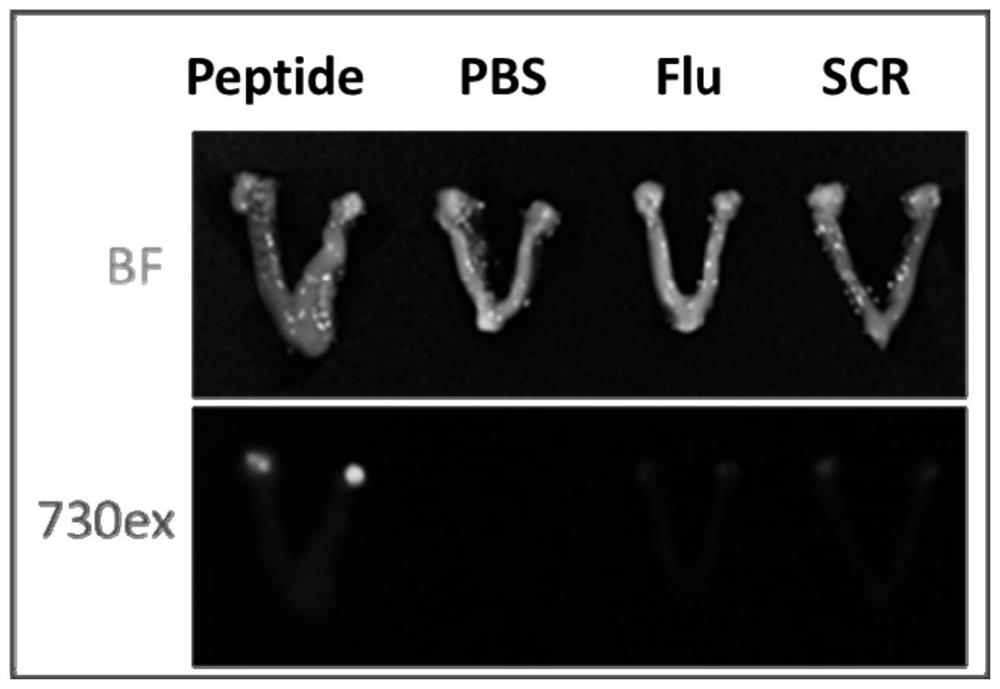Targeting ovary polypeptide and application thereof
An ovarian and targeted technology, applied in the field of biomedicine, can solve problems such as the advent of drugs, and achieve low risk of immune response activation, avoid side effects, and high selectivity
- Summary
- Abstract
- Description
- Claims
- Application Information
AI Technical Summary
Problems solved by technology
Method used
Image
Examples
Embodiment 1
[0093] Example 1 Targeting study
[0094] The modified product is selected from the product obtained by fluorescent group modification, or the product obtained by phosphorylation modification, or the product obtained by cyclization modification based on disulfide bond, or the product obtained by biotin labeling modification, or the product obtained by biotin labeling modification. Products modified with photosensitizers, or azide-modified, or PEG-modified, or methylated, or fluorescently quenched, or protein-coupled The product obtained by modification, or the product obtained by modification of small molecule compounds;
[0095] The modified polypeptide Peptide (shown in SEQ ID No. 1) is linked with a fluorophore, so that the polypeptide has fluorescence.
[0096] The mice were divided into four groups, namely Peptide group, PBS group, Flu group and SCR group. The polypeptide Peptide (Peptide group), PBS (PBS group), a single fluorescent material (Flu group) and a scrambled p...
Embodiment 2
[0099] Example 2 Therapeutic experiment on premature ovarian failure
[0100] Establishment of premature ovarian failure model: 8-week-old mice were selected and divided into 4 groups: experimental group CTX group (cyclophosphamide group), experimental group Peptide+CTX group, control group CTRL group and control group Peptide group.
[0101] Mice in the CTX group were injected with 75 mg / kg cyclophosphamide (CTX) on the first day, and then 30 mg / mL cyclophosphamide every other day for 3 weeks.
[0102] The mice in the Peptide+CTX group were injected with cyclophosphamide according to the dose and interval of the mice in the CTX group. Peptide was injected with a dose of 750 nM / g on the day before the first injection of cyclophosphamide. Three weeks.
[0103] Mice in the CTRL group (PBS group) were injected according to the dose and interval of the mice in the CTX group, except that cyclophosphamide was replaced with PBS.
[0104] The mice in the Peptide group used the same ...
Embodiment 3
[0118] Example 3 Therapeutic experiment on improving blood sugar elevation caused by metabolic disorder
[0119] A mouse pathological model of hyperlipidemia-induced polycystic ovary syndrome (PCOS) was established. The specific experimental process was as follows: C57 female mice (21 days old) in the experimental group were injected subcutaneously with DHEA (6 mg / 100 g body weight, 100 μL mice, sesame oil plus 95% ethanol) for 20 consecutive days, high-fat feeding (DHEA+HFD), part of which was injected with Peptide (DHEA+HFD+Peptide) at the same time. The control group was injected with 0.09 mL of sesame oil and 0.01 mL of 95% ethanol every day for 20 days, fed with normal feed, and injected with normal saline (CTRL). After the experiment, the glucose tolerance and insulin tolerance of intraperitoneal injection were detected. Polycystic ovary syndrome is both a reproductive disease and an endocrine disease, mainly because ovarian dysfunction leads to a decrease in estrogen a...
PUM
 Login to View More
Login to View More Abstract
Description
Claims
Application Information
 Login to View More
Login to View More - R&D
- Intellectual Property
- Life Sciences
- Materials
- Tech Scout
- Unparalleled Data Quality
- Higher Quality Content
- 60% Fewer Hallucinations
Browse by: Latest US Patents, China's latest patents, Technical Efficacy Thesaurus, Application Domain, Technology Topic, Popular Technical Reports.
© 2025 PatSnap. All rights reserved.Legal|Privacy policy|Modern Slavery Act Transparency Statement|Sitemap|About US| Contact US: help@patsnap.com



